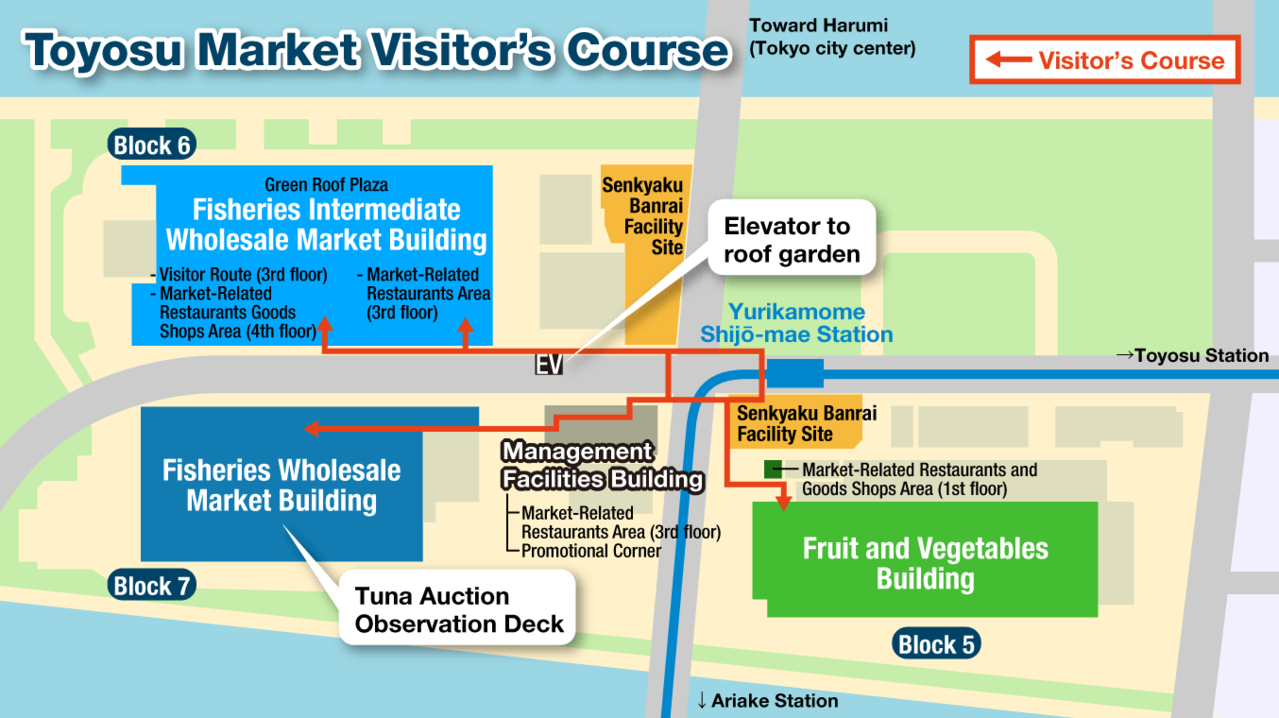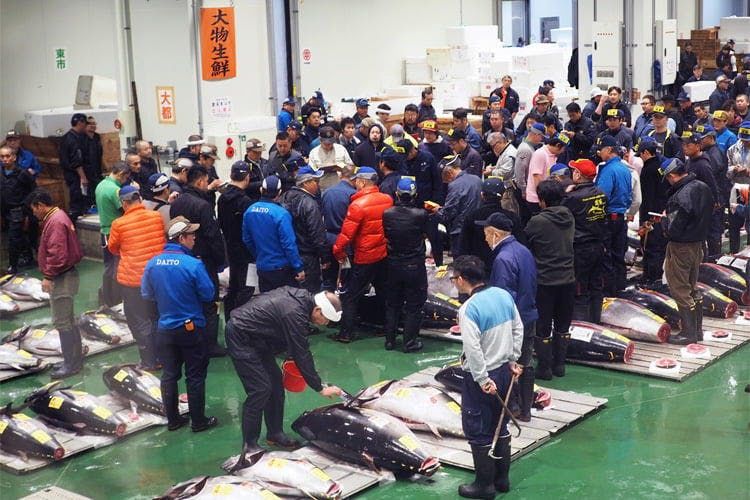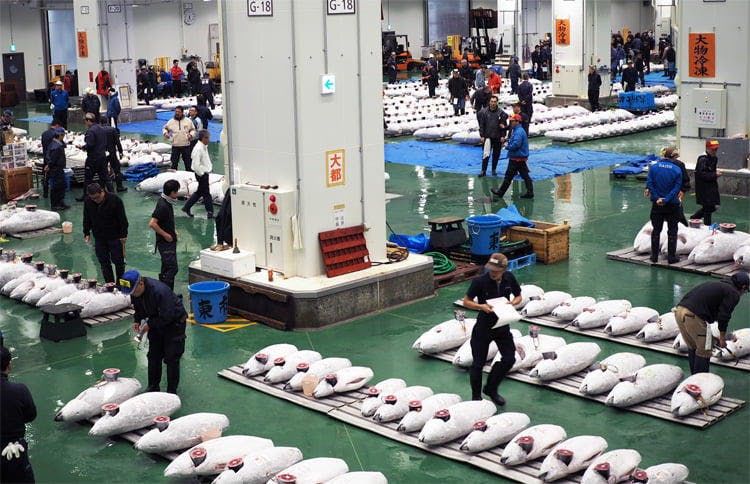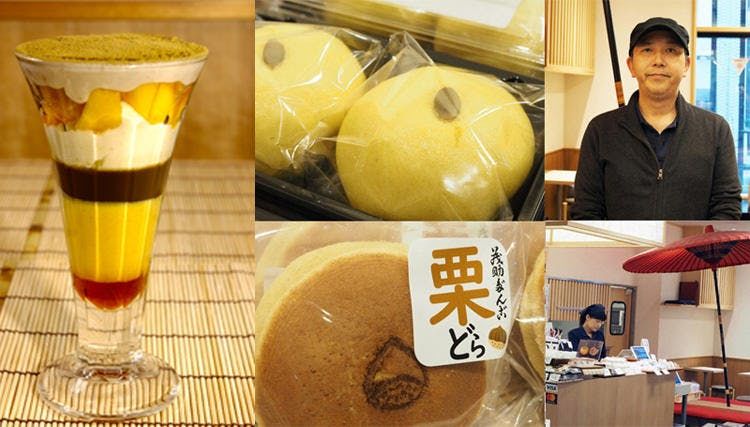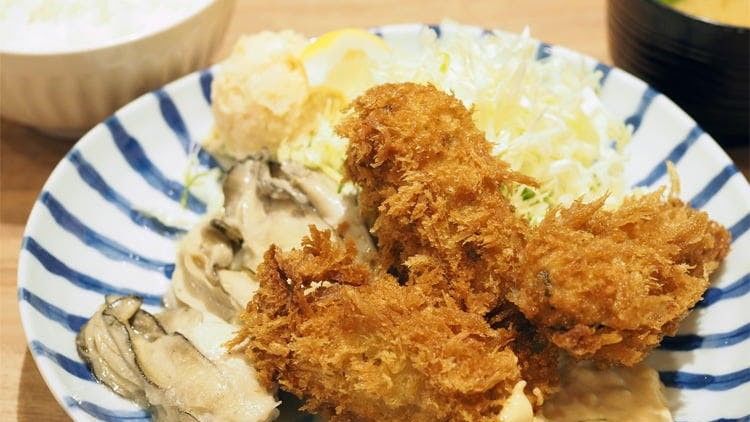
Insiders’ Guide to Toyosu Market: Bluefin Tuna Auctions and Many Culinary Delights
Guideto Japan
Food and Drink- English
- 日本語
- 简体字
- 繁體字
- Français
- Español
- العربية
- Русский
In this two-part feature on the Toyosu Market, Tsukijirō, an aficionado of the Tsukiji and Toyosu fish markets, highlights some of the sights that newcomers and repeat visitors alike can enjoy.
The dining and retail facilities in the Toyosu Market are located in the Fruit and Vegetables Building (Block 5), the Fisheries Intermediate Wholesale Market (Block 6), and the Fisheries Wholesale Market (Block 7). There are also observation galleries in Block 5 and Block 7 looking out on the fish market. The map below can be obtained at the Toyosu Market train station on the Yurikamome Line, so be sure to get it. Note that these facilities—including all the restaurants described below—are closed on Sundays, national holidays, and market holidays, so it’s best to check in advance to be sure things are open when you want to go.
A Look at the Tuna Auctions
The first thing most people want to see at Toyosu Market is of course the tuna auction action. The auctions take place from 5:30 to 6:30 in the morning, so visitors need to get up early and hop on the first train. The auction floor is visible to everyone from the walkway on the second floor of the Fisheries Wholesale Market Building, but it’s recommended that you go instead to Tuna Auction Observation Deck to get a closer look. From that up-close vantage point, you feel like you’re talking part in the auction!
Space is limited in the Tuna Auction Observation Deck, and access is limited to those who have applied in advance and successfully win a spot for the morning’s sale. The Tokyo government’s website provides English-language information on how to apply for a spot on the deck.
Tsukijirō describes the action in the auction space. “Lined up on the auction floor are around 200 fresh and 1,000 frozen bluefish tuna. At the sound of a clanging bell, the auction begins. The wholesalers, who have carefully evaluated the tuna in advance, use teyari hand signals as soon as the auction begins to indicate their asking prices, with each fish going to the highest bidder. The bluefish tuna, which can fetch hundreds of thousands of yen, are each sold in a matter of just seconds!”
Take a Break for Tea and Sweets
After checking out the tuna auctions early in the morning, it’s time for a little break. One popular snack to enjoy is the chewy dango dumplings at Mosuke Dango, made with flour milled from top-quality koshihikari rice. Dango have been a favorite of the fish market area since the late nineteenth century, when the market was located in Nihonbashi. The dango come in the refined sweet flavor of koshi-an (smooth sweet bean paste) and tsubu-an (whole sweet bean paste), as well as a grilled dango with lightly flavored soy sauce. Other popular dishes include freshly made wagashi sweets that change with the seasons, mochi (rice cakes), and sekihan (azuki-bean rice). Customers can also experience whisking their own cup of matcha to enjoy along with the sweets.
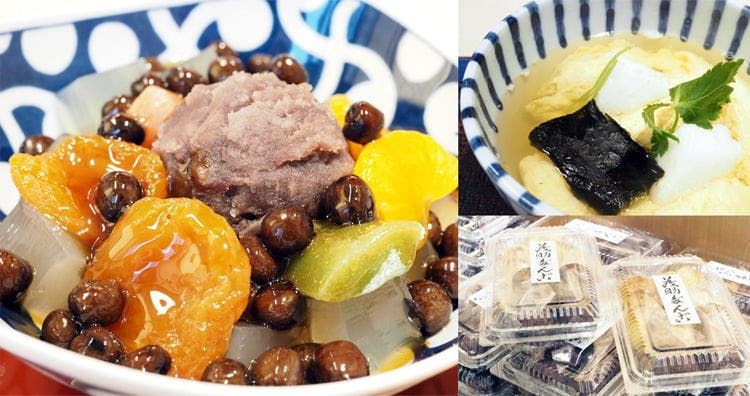
Clockwise from left: Mosuke Dango’s anmitsu dessert includes sweet bean paste and beans and fruit in a sugary syrup (¥621); the tamazō dish features egg, hanpen fish-paste cake, and grilled mochi rice cake in a seafood broth (¥650); packages of sweet treats are ready to be taken home for later. (All prices include consumption tax.)
“The anmitsu dessert served at Mosuke Dango is made with all homemade ingredients, except for the tangerines,” explains Tsukijirō. “It has a unique flavor and texture that come from a special blend of three types of agar. Those who only have an image of agar jelly as something smooth and translucent will be surprised, because here it plays the leading role! The sweetness of the bean paste and honey is an exquisite match for the sour apricots preserved in syrup.”
Along with its sweets, the shop is popular for rice balls and light dishes like ochazuke (hot green tea over rice). The soup dish named tamazō, full of fluffy eggs, feature a light broth made of bonito, kelp, and flying fish. The flavorful soup makes this the perfect dish to relax and recover after getting up so early in the morning.
Some items on the menu also change with the seasons. The shaved ice served in the summer is replaced in the fall with the Luxury Autumn Parfait (¥980, seen at left above) that brings together four seasonal delights: chestnuts, pumpkins, potatoes, and persimmons. Other items served exclusively in autumn and winter are the matcha latte and the azuki soup with chestnuts. Some takeout gift items recommended in autumn are the kuri dora, a pancake sandwich chock full of chestnuts in both the pancakes and the filling, and a manjū sweet bun that showcases the delicious flavor of pumpkin.
Mosuke Dango
3F Management Facilities Building (directly linked to the Fisheries Wholesale Market via the pedestrian walkway overlooking the tuna auctions)
Business hours: 5:00 am to 3:00 pm
Website: www.mosukedango.com (available in Japanese only)
Twitter: @mosukedango (posts in Japanese only)
The Hearty “Real Market Food”
If you are in the mood for the heartier fare that sustains the market workers every day, then stop by the restaurant Tonkatsu Odayasu. The restaurant, as its name implies, started off selling tonkatsu (deep-fried breaded pork cutlets), but later became known for fried seafood including horse mackerel, shrimp, crabs, scallops, oysters, puffer fish, and daggertooth pike. Special set meals that change daily include the slow-simmered fish or sashimi that the restaurant buys that day at the market. À-la-carte dishes include breakfast items and items that go great with a drink after work like shirasu oroshi (whitebait fish with grated daikon radish), maguro no butsu (tuna chunks), and aji no tataki (chopped horse mackerel sashimi). With so many choices on the menu, it’s hard to choose!
Tsukijirō is a fan of keeping track of what’s at its best at each time of the year. “Now that we’re entering oyster season, it’s the time for fried oysters and sautéed oysters with butter. But instead of choosing between the two, why not try the luxury of having both?” The oysters served at Odayasu, he notes, come from Hirota Bay in Iwate Prefecture. The big plump oysters are fresh and taste delicious when grilled in butter, while the fried oysters are crispy on the outside and juicy inside. “I recommend trying the first fried oyster on its own, squeezing lemon over the second, and then trying the third one with tartar sauce, to experience three different taste sensations. The shop’s master tells me that the biggest, richest-tasting oysters can be enjoyed at the end of the year, so I’m definitely coming back then!”

The Odayasu menu, at bottom left, is extensive. The daily specials are written on a board near the entrance (bottom right), while the regular menu items are on a blackboard inside. But sure to check out the white board first! Another popular item is the crab cream croquette (top right).
Tonkatsu Odayasu
3F Fisheries Wholesale Market
Business hours: 5:30 am to around 3:00 pm (last order: 2:00 pm)
Website: odayasu.net (available in Japanese only)
There are lots of other market food spots worth checking out Tonkatsu Yachiyo (3F Management Facilities Building), famous for its chāshū roast pork and egg dish, also offers horse mackerel fried in a blend of lard, beef tallow, and corn oil, making for a super-hearty market-food dish. Tsukijirō says that the fried mackerel was a particular favorite of the popular entertainer Matsuko Deluxe when he introduced it on her TV program.
The “modern-retro” Western-style restaurant Rokumeiken, with its dishes that include a ham-and-egg dish with a piece of ham that fills up the plate and fried shrimp that soar like towers, is described by Tsukijirō as the sort of place that “brings dreams of childhood to life.” The dishes are also very reasonably priced. Another recommended spot, especially at this cold time of the year, is Toritō (3F Fisheries Wholesale Market), a restaurant direct run by a chicken wholesaler. The restaurant’s mizutaki hotpot set meal—featuring a soup that the chef cooks for eight hours starting early in the morning—is amazing.
Don’t Forget the Noodles
If you want something even more filling, head over for a bowl of ramen at the Chinese restaurant Yajiman. Along with a variety of ramen offerings, the menu includes dozens of other menu items like fried rice, set menu dishes, donburi dishes served over rice, and steamed shūmai dumplings. At this time of year the oyster ramen is particularly popular, and sometimes the shop runs out of noodles on crowded days. But the staff is prepared to offer oyster wontons instead, or just oyster soup on its own, if you have to get a taste for yourself.
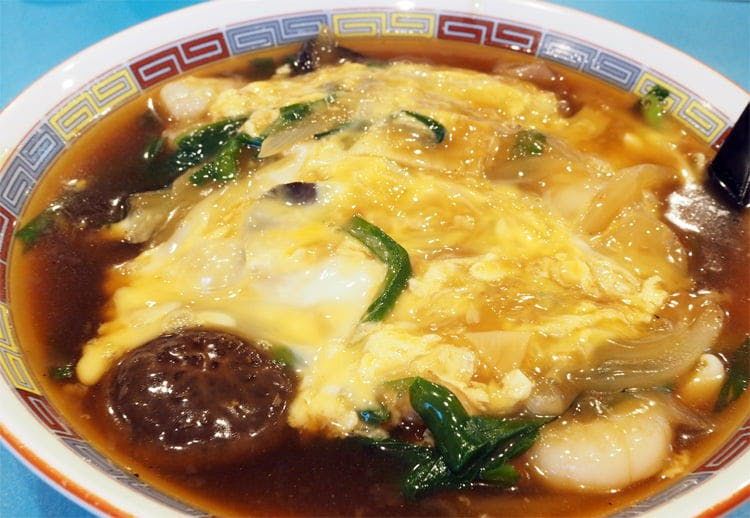
Ramen with nira chives and egg (¥1,000).
“Another popular dish is the nira and egg ramen,” reports Tsukijirō. “Just like its name implies, it’s a ramen dish topped with Chinese chives and egg. It also comes with tender shrimp and squid as well as onions. The restaurant’s oyster ramen is full of Jigozen oysters from Hiroshima Prefecture, with a savory flavor and seashore aroma. The rich soup is so good you’ll want to drink every last drop!”
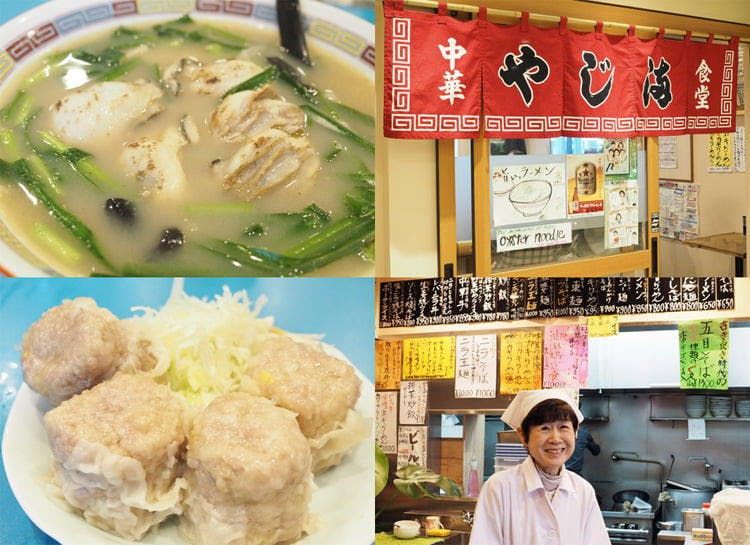
Clockwise from upper right: The oyster ramen (¥1,300); the Yajiman storefront and proprietor; and the celebrated shūmai dumplings (2 for ¥360 or 4 for ¥720), full of onions and meat.
Yajiman
3F Management Facilities Building
Business hours: 5:00 am to around 1:30 pm
Twitter: @toyosu_yajima (posts in Japanese only)
Another popular restaurant is Nakaei (3F Fisheries Wholesale Market), which has been serving Indian curry since 1912. Its seafood curry dish is full of the goodness of the ocean. An Italian option, Tomina (3F Management Facilities Building), is popular for its fresh seafood pasta and pizza.
Whether it’s ramen, curry, pasta, or many other dishes, Toyosu Market offers visitors many unique flavors to enjoy at its 39 shops and restaurants. Of course, many people visiting Toyosu Market are keen to try the sushi. Stay tuned for the next installment, where we profile the sushi restaurants in the market.
Tsukijirō
An ardent fan of the Tsukiji and Toyosu fish markets, he heads there or four times a week. Regularly posts information on his Japanese-language blog, Haru wa Tsukiji de asagohan (In Spring, Breakfast in Tsukiji). Also known for his appearances on TV programs spotlighting the fish markets.
(Originally published in Japanese by TV Tokyo Plus on October 25, 2019. Banner photo: Oysters both fried and sautéed at Tonkatsu Odayasu. All photos © TV Tokyo.)
https://www.tv-tokyo.co.jp/plus/
[Copyright © TV Tokyo Corporation. All rights reserved.]
